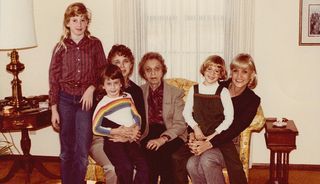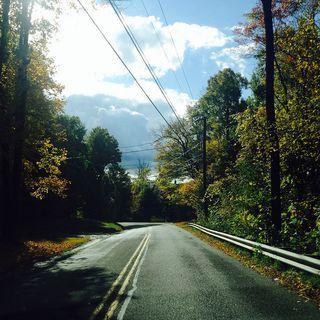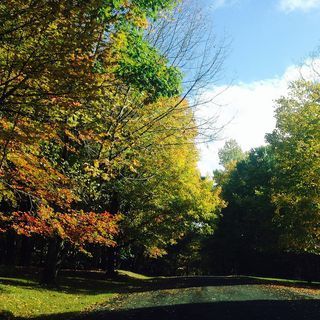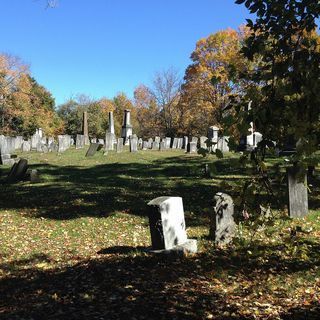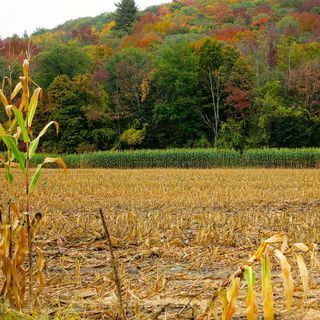Rachel Barenblat's Blog, page 144
October 16, 2014
The silence after the chant
 Today is Shemini Atzeret, 'The Pause of the Eighth Day.' Sukkot is a seven-day holiday. Today is day eight.
Today is Shemini Atzeret, 'The Pause of the Eighth Day.' Sukkot is a seven-day holiday. Today is day eight.
Shemini Atzeret has various customs, including reciting the memorial prayers of Yizkor. And the tradition offers beautiful supplicatory prayers to recite on this day which ask God for rain. (I wrote a contemporary one several years ago, in the form of a ghazal.) But my favorite teaching about today is that today is a day for sitting still.
The Hasidic rabbi known as the Slonimer Rebbe teaches that there are two days called atzeret, "pausing," during the year. On each of these days, God asks us to be people who choose to pause, to linger in the divine presence.
One of these days is Shavuot. Shavuot is called an atzeret, a day of holy pausing, and comes as the 50th day after the 49-day journey of Counting the Omer. And Shemini Atzeret is called an atzeret, a day of holy pausing, and it's also a 50th day; it comes after 7 weeks of the intense spiritual work of the high holiday season. Seven weeks ago was Rosh Chodesh Elul, the beginning of the month of teshuvah which prepares us for the Days of Awe. Count 49 days from Rosh Chodesh Elul, and the 50th day is today -- Shemini Atzeret.
The Slonimer concludes by saying that the white parchment of the Torah, which contains all of the letters, is holier than the words because it contains all of them within its field. Just so, he says, these days of pausing contain all of the holiness of the holy seasons each one comes to complete.
(I've shared this teaching here before, but I can't resist sharing it again -- I find it so beautiful.)
Today is a day to sit still and reflect on the journey we've just undergone. Rosh Chodesh Elul, the new moon of the month of Elul, fell on August 26 and 27 this year. What has your life contained since then? What was Elul like for you? Did you read (or write) #blogElul posts? Did you spend time thinking about your relationships and what might need healing or re-alignment?
What were the High Holidays like for you this year? Did you hear the shofar at Rosh Hashanah? How were the aseret y'mei teshuvah, ten days of re/turning? Remember Yom Kippur? Did you hear Kol Nidre? Did you pray in community, or did you pray alone? Did the experience move you? Did you come away feeling changed?
What was Sukkot like for you this year? Did you sit in a sukkah? Did you welcome supernal guests? Did you experience the great outdoors? Did you contemplate fragility, impermanence, what fades and what lasts?
Over the last seven weeks maybe you've been joyful. Maybe you've experienced sadness. Maybe you've felt hopeful. Maybe you've felt grief. Maybe all of the above. Sit for a minute and remember. That's today's work: remembering and integrating everything we've experienced over the weeks since late August, since the month of Elul began.
I love the rituals and liturgies, the words and customs, the melodies and practices of these seven weeks. And I love this teaching from the Slonimer which reminds me to cherish the pausing as much as I cherish the doing. Rabbi Shefa Gold teaches that a chant isn't complete until we also sit with the silence which resounds when the audible singing is through. "When the sound of a chant has ended," she writes, "the most subtle, transformative and powerful part of the practice can begin." Today is the silence after the chant. Listen to your heart in the silence. Feel whatever arises.
The pause of Shemini Atzeret is the chatimah, the seal, on everything we've experienced in the last seven weeks. The spaciousness which puts all of the holidays' busy-ness into a different perspective, the white space in which holy words are tenderly cradled, the silence after our seven weeks of song.
October 15, 2014
Good grief
Grief is a funny thing. A peculiar thing, I mean, not an entertaining one. It creeps in unexpectedly when everything seems fine, silent as Carl Sandburg's fog which "comes / on little cat feet." It does not listen to reason. It pays no attention to any list of gratitudes. When it wells up, cue the waterworks.
Grief brings fragility. As though the delicate eggshell of the heart could crack open at any moment, revealing an endless salt wellspring. Even writing about it from a distance, I want to keep it at arm's-length. I use stock phrases: "a funny thing," "cue the waterworks." I'm deflecting to keep it at bay.
Grief doesn't only come in the aftermath of loss. There's anticipatory grief, awareness that a loss is coming. And sometimes losses compound one another. The loss of health. The loss of the unthinking freedom which comes with health. The loss of an anticipated future, of what one thought would be.
Grief is, I find, not like depression. When I have experienced depression it has placed a scrim between me and the world, whereas grief leaves one exposed and open. When I can head depression off at the pass, that's a good thing, whereas trying to evade grief seems emotionally and spiritually unwise.
Also unlike depression, grief has a known cause: loss, or the expectation of loss. It's not an existential sadness without explanation. Grief has meaning. As Rabbi Matthew Gewirtz has written, grief can offer the gift of transformation when we allow ourselves to feel it fully and to be changed.
I think back to conversations I had with my first spiritual director when I had my strokes. We spoke often about the challenges of equanimity. What might it mean, he asked, to respond to uncertainties about my health with equanimity? Could I make a practice of trying to accept whatever would be?
It is easier to bring equanimity to bear on uncertainties about my own health than on uncertainties about the health of someone I love. When the prognosis is not good, and none of us can know exactly what will happen next, the path toward equanimity detours often into the dips and valleys of grief.
I think of the verse from Psalms which my friend Rabbi Brant Rosen cited recently -- "God is close to the broken-hearted." This is another way that grief feels different to me from depression. When I have been depressed, God has felt absent. When I grieve, I know God is with me. There's comfort in that.
Everyone wants their loved ones to be healthy and whole, though we know that can't always be true. Grief may arise when we bump up against the disjunction between what we'd hoped for, and what may actually unfold. And we have no control over what cards we, or our loved ones, may be dealt.
Sickness and mortality are part of life. As a rabbi who has tended to others navigating these truths, I know that grief is a healthy response. If we try to numb ourselves from anticipated loss, the emotional waves will do more damage than if we just let them roll in over our heads and then melt away.
There's a parable about creatures living at the bottom of a rocky river, clinging to the stones in the current and being battered by the waves. And then one of them lets go, and discovers that the current is not an enemy but a friend. One can float safely over the sharp rocks, if one can trust and let go.
I trust that with such release, the currents of grief lead to shores of comfort. Safe shores where one can look back without regret, where one can cultivate gratitude without needing to pretend that there is no sorrow. Where loss, actual or anticipated, is outweighed by the continuing joy of connection.
Over the last few months I've been privileged to read near-daily postings from Eve Ilsen, trained dreamworker and rabbinic pastor, as she navigates her grief in the wake of the death of her husband Reb Zalman, may his memory be a blessing. Watching her walk the mourner's path moves me deeply.
I know there's a limit to how much one can learn by reading about someone else's emotional journey. But I've found it valuable to read about her grief's ebbs and flows. She's writing because doing so brings her comfort and connection, not to teach me (or anyone), but I'm grateful for her teaching.
And I want to acknowledge that there's a difference between grieving someone like Reb Zalman who had a long and fulfilling life, and grieving the loss of a child. Watching Superman Sam's parents grieve online humbles me and breaks my heart. To bury a child is an inversion of the natural order of things.
To be the grown child who eventually buries a grandparent, a teacher, a parent is not something one wishes for. But it's the way life works. How fortunate we are, we who are blessed to have beloved elders well into our own adulthood, we who eventually have to face their fragility (and our own).
Sometimes grief comes and goes like contractions. Fierce enough to steal the breath, and then it's gone, and then it returns. And as with labor, there's no way out but through. All anyone can do is keep breathing and let the tears come. Let go of the rocks and trust the current. Let the waves flow.
And when it is gone, how are we changed? What spiritual and emotional gifts might grief bestow, if we are open to receiving them? I think we feel grief for a reason. There is work it does in us. What can we learn from its visitations? How would it feel not to fight it, but to invite it to help us heal?
If you are grieving...
20 tips for grieving, from the Good Grief Center
Some Jewish resources for grief, loss, and bereavement, compiled by Nahama Shudofsky and Simkha Weintraub
A Buddhist perspective on grieving by Roshi Joan Halifax
Apples and honey; falling leaves
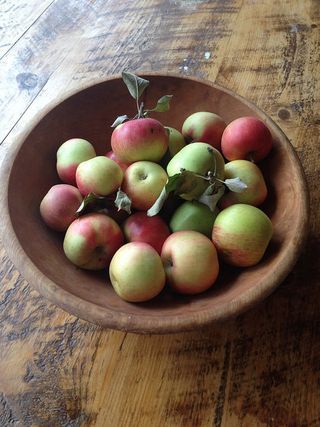 All the world feels redolent with apples and honey at this time of year. I've taken our son apple-picking twice since Rosh Hashanah. We go to a local orchard, only a few minutes away from our house. I love the palpable abundance of apple trees laden with fruits. And there's nothing else quite like the spicy-sweet crunch of a honeycrisp apple, especially one we've just plucked from the tree.
All the world feels redolent with apples and honey at this time of year. I've taken our son apple-picking twice since Rosh Hashanah. We go to a local orchard, only a few minutes away from our house. I love the palpable abundance of apple trees laden with fruits. And there's nothing else quite like the spicy-sweet crunch of a honeycrisp apple, especially one we've just plucked from the tree.
And when I look out the window in the morning, or step outside into the sukkah, or walk around the playground, the trees are brilliant orange and yellow. When the sunlight filters through their leaves, the very air feels honey-colored: golden and bright. The hillsides are an autumnal kaleidoscope, shifting and changing as the jewels of the leaves tumble, catch the light, float through the air.
It's easy to wish, "if I could only capture this moment!" Right now, with the trees all rustling and brilliant, with the sukkah standing proud in the backyard, our son singing silly songs in the car on the way to preschool. But even as it's happening, it's changing. Already some of the trees have lost the leaves at the top of their highest branches. The end of one thing, the beginning of the next.
Today is the seventh day of Sukkot, also known as Hoshanna Rabbah. Rabbah means great; hoshanna means "please save us!" In many communities people gather today to recite hoshanot, prayers which beseech God to save the earth. In the immediate aftermath of the climate march, with the drumbeats of the need for change ringing in our ears, these prayers take on a different urgency.
This year of 5775 is a shmita year, a sabbatical year, during which Torah teaches we are not to harvest in the land of Israel but instead to let the earth rest and lie fallow. "By the time the next shmita year rolls around," one of my colleagues said to me recently, "it will be too late to turn the earth around." A sobering thought. Ana Adonai, hoshia na -- please, God; please save us! -- takes on new resonance.
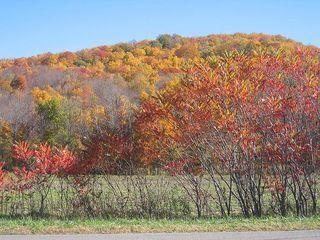 Another Hoshanna Rabbah custom is circling the sanctuary seven times holding our lulavim, the bunches of branches with which we have beckoned blessings all week, and then beating the willow branches against the ground. The falling leaves represent the rain which is always so urgently needed in the Middle East.
Another Hoshanna Rabbah custom is circling the sanctuary seven times holding our lulavim, the bunches of branches with which we have beckoned blessings all week, and then beating the willow branches against the ground. The falling leaves represent the rain which is always so urgently needed in the Middle East.
We don't observe Hoshanna Rabbah in any formal way in my congregation. There will be no circumnambulations of the sanctuary, no beating of willow branches against the patio stones. But I will watch leaves fall from birch and oak and maple as the day unfolds. They drift and spiral to the ground, and they evoke the precipitation which I know will fall as the season deepens. Already our lawn is becoming obscured by their fading colors.
I know that it won't be too long before the lawn is obscured instead by fallen snow. And then it will be green again, and so will the trees. The end of one thing, the beginning of the next. I read recently that the leaves of our deciduous trees contain these astonishing pigments all the time, but when photosynthesis is happening, the chlorophyll obscures the reds and oranges and golds.
And then the trees gracefully let go of the need to keep producing food, trusting that their reserves will see them through what's coming, and for a gleaming fiery moment their hidden brilliance can shine.
October 14, 2014
How to Build a Time Machine
Start with two-by-fours and bolts.
Fashion a rectangle. Add crossbeams.
Then attach four posts sticking up
like the frame of an old-fashioned bed.
You'll need another pair of hands
to invert it, a wobbly table
higher than you are tall.
Lattices brace, giving the illusion
of wall. Hurl cornstalk javelins
onto the sketch of a roof. Thread
strands of light around the rafters,
golden garlands between the corn.
Hang variegated gourds beside
whatever shiny art or gadgetry
appeals to the five-year-old eye.
When the last paperclip is hooked
you're ready to step inside.
Wave palm fronds until they clack,
thumb the etrog and breathe deep.
Notice the sky change.
There's no controlling
where it will take you: to last year?
To next year? To the year when illness
revealed the fragility of your veins?
Or maybe to the forty years' wandering,
smoky cookfires and bleating goats,
nights beneath the tender curl
of God's sheltering embrace.
When you re-enter your old house again
don't be surprised if the ceiling
seems too plain. The side effects
are temporary. At week's end
pack the holy components
back in the Rubbermaid ark. Return it
to the basement. Unscrew the walls
and lean them against the garage
where they'll linger, inanimate
logs waiting to be lashed together again
into the raft which will ferry you
across next year's unknown seas.
I found myself wanting to write a poem but casting-about for inspiration. So I turned to the list of poetry prompts which Luisa Igloria shared last National Poetry Writing Month, and chose the one for the 13th day of that month: Write a poem which incorporates a set of instructions on how to get somewhere specific, and then on returning or coming back. The "somewhere specific" wound up being more a state of mind than a literal place, and I suspect the poem will become much shorter in revision at some point, but for now, I'm pleased with it.
October 11, 2014
What we remember
My maternal grandmother; her two daughters; three of their daughters, including me.
Sometimes I wonder: what stories will our son tell about his growing-up, in years to come? How will he remember his childhood? What memories will he seize onto and hold fast amid the swirl of all the other memories which wash away? Sometimes I can't believe that he won't remember much of these early years. How can it be that he won't remember last night's potluck dinner in the synagogue sukkah, sitting at the kids' table, singing along with the Shabbat blessings, and then whooping and laughing while playing tag with the other kids in the deepening dark outside the sukkah which gleamed with strings of little lights?
And yet I don't remember much about being five, much less the years which came before it. My fifth birthday party was a dress-up party at a fancy restaurant called the University Club, at the top of one of the few tall buildings near our neighborhood. I remember dressing up in one of Mom's blue dresses -- made of crinkled chiffon, I think, or something like it -- and wearing a big strand of her pearls and a floppy sun hat. I remember that she asked if I wanted to pierce my ears to surprise my father, but I wasn't ready to do that, so we got me clip-ons instead. I remember the scratchy gold ribbon which held the high heeled shoes on my feet. Do I remember this because there is a Polaroid picture of it and I've had that photograph to remind me in the interim? Am I remembering a memory of a memory?
I must have been attending the Judson Montessori school then, in the old church building just around the corner from the Pontiac dealership. I remember painting at an easel, doing math with sticks which represented tens and hundreds, looking at a timeline made out of felt which depicted the earth's history. (Most of it was black, denoting the time when the earth formed and cooled. Then there was green for the time when plants arose, and yellow for the dinosaurs, and human history was represented by a tiny nubbin of red felt at one end.) I remember eating meals there while listening to Ravel's "Bolero." I remember coming home and throwing tea parties with my miniature set of rose-printed china, filling the tea cups with Bosco-flavored chocolate milk.
A basically happy childhood blurs together in memory. We remember the unusual moments against the backrop of undifferentiated normalcy. (Take the winter of 1985: I remember the "San Antonio blizzard of '85" which dropped thirteen inches of snow on my hometown, and I remember my middle brother's wedding the week of that blizzard, but the rest of the season is lost to me now.) As we age, it seems, our more recent memories are stacked on top of the pile and the oldest memories compress like flakes of soft snow packed over centuries into glacial ice. What would it take to find those memories again?
Tastes can open up memory. There was a day recently when I had salami and eggs for breakfast and was bowled-over by two distinct sense-memories: one of eating my mother's salami and eggs in the breakfast room of my childhood home, the other of eating my grandfather's salami and eggs at their round breakfast table. (My grandfather cut the salami differently, and cooked the eggs harder.) Music can open up memory. I heard a snatch of George Winston's "Autumn" the other day and it transported me. I had forgotten how much my mother loved that tape (because I'm pretty sure it was a tape, back when we used to play it), and how often those notes used to roll through our living room.
There are a handful of memories which rise up for me repeatedly. It's as though I left a path open to these rooms of memory, and because I've traveled that path so many times, the path remains easy to find. One is a memory of going with my mother to the Olmos Beauty Salon which was a few blocks away from our house. She would get her hair done and I would play with the rainbow-colored foam curlers, from the biggest ones (red) to the smallest ones (purple), making them into chains or dragons. I think of our visits to Olmos Beauty Salon every single time I go for a haircut. As I tip my head back into the shampoo sink, I remember watching my mother do the same.
Another is a memory of the particular marble tile in her dressing area where I used to crouch to watch her put on makeup. As a child I could perch for hours in a kind of tailor's squat. (Adults used to marvel at that, and I used to think: what do you mean, this isn't comfortable for you?) I can still hear the particular rattle of her makeup drawers pulling open, can still smell the spritz of Bal á Versailles perfume. And while she put on makeup or did her hair we would talk about things. There was nothing unusual about hanging out and watching Mom put on makeup. Maybe the memory has stayed with me because I did it so often. But why that memory, and not the memories of a hundred other things we did routinely?
I can remember the wallpapered ceiling of my childhood bedroom, and the slight dip in the bed from where Mom sat beside me. I can still recite the litany of family names I used to ask God to bless every night -- even though some of those names belong to family members who are now long gone. I do this with my son now, exactly the way Mom used to do with me, and I sing the shema using the same melody she used with me. And as I tuck him in, I sing "I Love You (A Bushel and a Peck)," which I have taught to him as my mother taught it to me. Surely he will remember that... though he'll remember the aggregate of a thousand bedtimes, not any particular night.
The photograph at the top of this post was recently unearthed. Looking at it, I get glimpses. I remember each of us looking like that, though the children in the photo are grown women and the matriarch in the photo is long gone. I remember childhood trips to New Ulm to see my Minnesota cousins. The photo paper has faint red lettering on the back which reads "Fox Photo / This paper manufactured by Kodak. Oct 81." But we didn't write anything else on the photograph, and if it once inhabited an album, that album is long gone. Who knows anything else about the moment when this photo was taken? What had we just been doing? What was for dinner that day? The details have faded away.
I'm grateful for the gift of a childhood in which the only events which stand out are the happy ones -- recurring ones like Rosh Hashanah lunch at my grandparents' house or Chanukah decorations in our dining room, individual ones like my sister's wedding in the front yard of my childhood home. This is one of the great mysteries of parenthood, I think: that a million individual acts of kindness and caring dissolve into the smudged backdrop of remembered childhood. My parents may remember details of pacing with me when I had croup, or shopping with me for school supplies year after year, but those memories are lost to me. In Jewish tradition we speak of caring for the dead as the mitzvah which can't be repaid, but there's a way in which caring for a young child is that kind of mitzvah, too. It can only be paid forward.
October 9, 2014
Letter from the sukkah
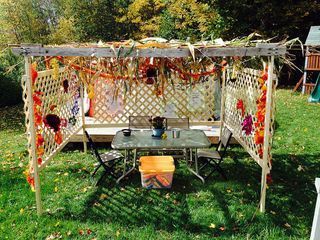 On the festival's first night I carried a tray out to the sukkah bearing dinner, kiddush cups, wine and juice, a lighter for the candle I encased in a many-pointed glass star so that the wind wouldn't blow it out. Our son complained that he couldn't see the moon, but we came back outside later when it had just risen -- huge and yellow over the dark horizon of the hills -- and he jumped up and down with joy.
On the festival's first night I carried a tray out to the sukkah bearing dinner, kiddush cups, wine and juice, a lighter for the candle I encased in a many-pointed glass star so that the wind wouldn't blow it out. Our son complained that he couldn't see the moon, but we came back outside later when it had just risen -- huge and yellow over the dark horizon of the hills -- and he jumped up and down with joy.
I spent much of the first day of Sukkot bundled up in the sukkah: jeans, socks, fuzzy slippers, a shirt, a sweater, a jacket, a knitted hat and scarf, and fingerless gloves. Above me the cornstalks rustled in the breeze. Occasionally yellow maple leaves drifted down from one of the trees overhead and made their way through the schach of the roof to land on my laptop. I was chilly, but I stayed out for a long time.
Being in a sukkah feels like being indoors and outdoors at the same time. The fresh air says "outdoors;" the feel of roof and walls says "indoors." But not too indoors. I can see sky through the roof. The usual views of our backyard and the valley are broken into squares by the sukkah's wooden lattice. All around me, decorations and our son's apple-themed art hang as though in midair.
Sukkot is so short, in the grand scheme of things. Seven days. I didn't want to miss it; I didn't want to waste it sitting indoors at the desk where I sit the whole rest of the year. The commandment is leishev ba-sukkah, "to dwell in the sukkah" -- literally, "to sit in the sukkah," which always makes me think of sitting zazen. The point of sitting in the sukkah is just sitting in the sukkah. Gloves and all.
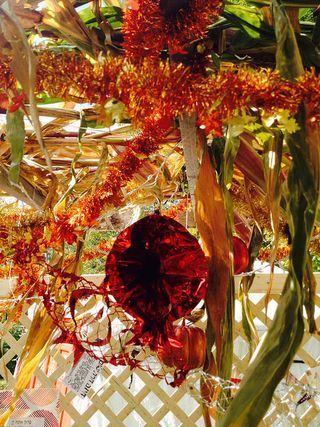 I try repeatedly to photograph our sukkah in a way which would show you what it looks like, what it feels like. But as with the panorama of the autumnal Berkshire hills, the pictures of the sukkah don't capture its reality. Autumn light streaming past golden tinsel garlands and shiny glitter pumpkins, the endless soft rustle of the roof, the little lights which gleam at nightfall. All I can capture are glimpses.
I try repeatedly to photograph our sukkah in a way which would show you what it looks like, what it feels like. But as with the panorama of the autumnal Berkshire hills, the pictures of the sukkah don't capture its reality. Autumn light streaming past golden tinsel garlands and shiny glitter pumpkins, the endless soft rustle of the roof, the little lights which gleam at nightfall. All I can capture are glimpses.
The sukkah has to be experienced in four dimensions, including time. The sukkah only exists for a short window of time. And yet the sukkah is also a portal in time, a door to every other year when I have sat in a sukkah. The ghosts of ten sukkot are imprinted on this back yard. Surely God, Who inhabits all of space and time simultaneously, can see next year's sukkah, and the next, and the next...
In the sukkah I can hear crickets chirping. Soon hard frosts will quiet the hillsides. Soon -- but not yet. On the first evening of the festival, as we ate dinner in the sukkah, we listened to an invisible neighbor playing "Auld Lang Syne" on clarinet. Our own private Sukkot serenade. The soundscape of the week also includes chipmunks rustling in the hillside's fallen leaves, and Canada geese calling overhead.
The sukkah, some say, represents the cloud of glory which followed the Israelites in their 40-year wilderness wandering. This is a house of divine presence. The walls and roof may be barely-there, but Shekhinah surrounds me with her embrace. I think of the angel song, that prayer for surrounding our son with wonder, strength, light, comfort, and the presence of Shekhinah all through the night.
Weather will blow in. Eventually the sukkah will come down. Temporariness is an inextricable part of the design. And yet this is where we're supposed to rejoice. Not despite the leaky roof, short lifespan, short-term design -- but with them, in them, through them. Go outside in order to go inside. Through this parody of a roof, recognize the sheltering Presence which curls protectively over us all.
Inviting (science) fictional ushpizin
There's a Jewish custom of inviting ushpizin, holy guests, into the sukkah each night. In the most traditional paradigm one invites seven (male) Biblical figures; in a more contemporary paradigm one invites Biblical figures of both genders. Each of the invited guests represents or channels a particular mystical energy, so in calling on that figure to invite them to one's sukkah, one is also inviting that figure's qualities to flow into the sukkah and into one's life.
For instance, on the first night it's traditional to call on Abraham. In kabbalah, Abraham is connected with the sefirah (divine quality) of chesed, overflowing lovingkindness. On the second night, one would call on Isaac, who is associated with gevurah, boundaried strength. (And so on.) Here's a lovely Seder Ushpizata by Rabbi David Seidenberg -- a liturgy for inviting and calling-upon these incorporeal guests and their holy qualities. And here's a fantastic infographic on the ushpizin, which lists the traditional (male) ushpizin, an alternative list of female ushpizot, and even a set of Hasidic figures who can be mapped to the seven nights of the festival.
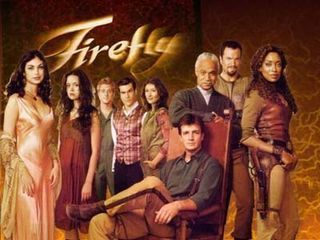 Shortly before the holiday began I found myself pondering aloud on Twitter how one might map these seven kabbalistic qualities to characters from Firefly. The tweet drew enough response that I figured it was worth expanding into a post! If one wanted to welcome the crew of Serenity on all seven nights of Sukkot, in what order would they be called-on, and what qualities would we ask them to channel for us?
Shortly before the holiday began I found myself pondering aloud on Twitter how one might map these seven kabbalistic qualities to characters from Firefly. The tweet drew enough response that I figured it was worth expanding into a post! If one wanted to welcome the crew of Serenity on all seven nights of Sukkot, in what order would they be called-on, and what qualities would we ask them to channel for us?
(If you are not a fan of Joss Whedon's tragically short-lived "space western" Firefly, the remainder of this post may hold limited appeal for you. No disrespect is intended, in this bit of whimsical geekery, to the traditional custom of inviting Biblical ushpizin.)
Here are the answers I came up with:
Chesed, lovingkindness - Kaylee Frye. It's not a stretch to see Kaylee as an avatar of chesed. She's kind, generous, sweet, and loving. And I can see her as a face of hospitality, as was Abraham (with his tent open on all sides / to all comers.) In the very first episode we see her welcoming Simon Tam and Shepherd Book aboard. Surely, like Abraham, Kaylee would welcome anyone into her home / onto her ship. On the first night of Sukkot, we would invite Kaylee to bring lovingkindness into the sukkah.
Gevurah, boundaried strength - Malcolm Reynolds. It was gevurah that got Mal through the war and it's gevurah which keeps him at the helm. He has to be strong in order to deal with some of the unsavory characters with whom they have to work. Sometimes it seems as though he thinks he can keep the ship flying by sheer effort of will. It's also possible that he's right about that -- as long as he's not doing it alone; he needs the other qualities manifested by the rest of the crew. On the second night of Sukkot, we would invite Mal to bring strength into the sukkah.
Tiferet, harmony / balance - Inara Serra. I think about her lighting incense at the altar in the Companion training house, ritualistically pouring tea for her guests, creating sacred space in her shuttle through tapestries which obscure its gunmetal functionality. These are acts which create harmony around her. Kabbalistically, tiferet is a balance of chesed and gevurah, and I can see Inara having both some of Kaylee's lovingkindness and Mal's strength. On the third night of Sukkot, we would invite Inara to bring harmony into the sukkah.
Netzach, endurance - Zoe Washburne. Zoe served as a Browncoat, a fighter in the rebellion against the hegemonic Alliance, and the battle of Serenity Valley required netzach aplenty. Zoe has no shortage of steely-eyed resolve. And, of course I think of Zoe at the end of the film Serenity, and I think: come what may, Zoe endures. On the fourth night of Sukkot, we would invite Zoe to bring endurance into the sukkah.
Hod, humility / splendor -- Shepherd Book. Hod is an unusual mixture of regal presence and humility, and the good Shepherd is a fine avatar for that combination. Sometimes we see his humble simplicity, when he's inhabiting the role of the unassuming Shepherd, presiding over the dinner table; sometimes we see hints of his splendor, as when the show offered tantalizing glimpses of his past. He manages to embody both of these qualities at once. On the fifth night of Sukkot, we would invite Shepherd Book to bring humble splendor into the sukkah.
Yesod, foundation - Wash Washburne. While some would interpret Yesod as generativity or sexuality (in which case perhaps Inara would be a better choice), I like to think of Yesod as what keeps us rooted. Although it was his job to pilot Serenity through air and space, Wash kept the crew emotionally grounded. Some interpreters connect yesod with peacefulness, and it's notable that Wash wasn't a soldier -- he comes from the side of peace. On the sixth night of Sukkot, we would invite Wash to bring groundedness into the sukkah.
Malkhut, sovereignty / nobility - River Tam. Malkhut is also called Shekhinah, and I can see River with her fierce balletic grace as an avatar of the divine feminine. Perhaps in her pre-Miranda anguish she represents the exiled Shekhinah, distant from her own wholeness -- and after unearthing the injustice done to the inhabitants of that planet she's able to integrate, immanence balancing with transcendence. On the seventh night of Sukkot, we would invite River to bring the presence of Shekhinah into the sukkah.
Of course, there are nine characters aboard Serenity and only seven of these "lower" sefirot; I've left Jayne Cobb and Simon Tam off the list. But in looking at how the characters map to the sefirot, I'm struck by the range of their emotional and spiritual qualities. Their differences are complementary. I suspect that's part of why they make such a successful crew. Tradition teaches that when we bring together the qualities of all seven lower sefirot, we glimpse a reality-map of the balance of divinity. The whole is more than the sum of its parts. The same is true, I think, for this set of characters and the qualities they embody: they are more, together, than the sum of their individual parts.
Would you map them differently? Or have you ever invited other literary or televisual characters into your sukkah? (Joy Fleisig tweeted me a link to a graphic mapping Harry Potter characters to the seven ushpizin, so I know I'm not the only one who's had this kind of nutty idea -- though I'm not sure I agree with all of the choices in that graphic; I wouldn't have included Voldemort at all, as he is not the sort of personage I would want to invite into my sukkah, even metaphorically.) Thoughts on the intersection of ushpizin and fandom? Tweet me at @velveteenrabbi or leave a note in comments...
October 8, 2014
Fall's beauty
At this time of year I want to take photographs all the time. Everywhere I look, fall colors blaze. The hillsides are a slowly-shifting tweed of late-summer green, orange, yellow, rust, and bright flares of pure red. Every day the color balance is different. Every day the color balance is beautiful.
When light shines through the trees everything looks golden. Against the backdrop of dark clouds, the colors pop. And I know that at any moment the winds or the rain could knock the leaves off the trees and reveal bare branches beneath. Part of what makes it so gorgeous is that we know it can't last.
Fall highlights the reality that everything in the world is always changing. I want to capture the beauty as though I could keep it, hold on to it, save it for another day. And I can -- to an extent. I can photograph it and write about it and remember it. But I can only inhabit the now right now.
This is one of the lessons of Sukkot for me each year. The beauty around me is always changing. We build the sukkah and it is beautiful. We decorate it, and it is beautiful. And as soon as it's built, it starts to come apart, and that's beautiful too. The trick is learning how to see the beauty in its changes.
The challenge is finding the beauty in what is -- whatever is. Saying thank-you to God for the radiant splendor of a northern Berkshire autumn -- and for the muted colors which will follow it. This moment is all there is, and it is always passing. And it is always right now. And it is always beautiful.
October 7, 2014
Relearning how to slow down
Sometimes it's a little bit difficult for me to wind down after the holidays.
There's so much to do in preparation for Rosh Hashanah and Yom Kippur. The most important parts for me are liturgical (practicing parts of the service with my hazzan, talking through transitions, trying out harmonies) and language-based (sermons, sermons, sermons), but there are preparations in other realms, too. From finding the white kippot at shul and putting them out for use during the holiday season, to making sure we have enough yizkor / memorial candles, to doing a sound-check with the microphones...the list is lengthy. (And did I mention the start of the Hebrew school year, conveniently timed?) My half-time job becomes fulltime. Since sometime this summer, the Days of Awe have been at the forefront of my consciousness all the time.
And suddenly they're over.
And what comes next -- starting tomorrow night -- is a week-long festival where I'm supposed to just sit. It's a bit of a shock to the system.
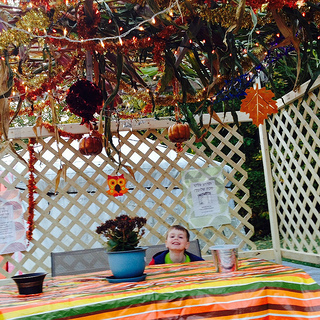 Okay, building the sukkah takes work. But that's Ethan's job; he's the carpenter in our family, and on Sunday he built us a beautiful new sukkah with latticed walls. Decorating the sukkah is the task which falls to me and to our son, but that's not work by any stretch of the imagination -- it's play. We festoon the structure with autumn-colored tinsel, tiny lights, gourds and pumpkins, giant leaves and acorns made out of felt, and a pair of shiny red pomegranates which our son calls "jewels." (They do look rather like jewels.) Over the course of the week he'll make more decorations. By the end of the holiday I expect the walls will be entirely covered in his handiwork.
Okay, building the sukkah takes work. But that's Ethan's job; he's the carpenter in our family, and on Sunday he built us a beautiful new sukkah with latticed walls. Decorating the sukkah is the task which falls to me and to our son, but that's not work by any stretch of the imagination -- it's play. We festoon the structure with autumn-colored tinsel, tiny lights, gourds and pumpkins, giant leaves and acorns made out of felt, and a pair of shiny red pomegranates which our son calls "jewels." (They do look rather like jewels.) Over the course of the week he'll make more decorations. By the end of the holiday I expect the walls will be entirely covered in his handiwork.
And yes, there are mitzvot (connective-commandments) associated with this festival. I'll take up my Four Species and wave them in all directions, beckoning blessing. I'll sing the psalms of Hallel. I'll have friends over to rejoice in the sukkah with me. But that's it. None of this holds a candle to the work -- both practical and spiritual -- of the High Holidays! The mitzvah of Sukkot is mostly just being. Being in the sukkah. Sitting in the sukkah. "Dwelling" in the sukkah (or at least eating meals there, weather permitting) and feeling joy in the sukkah.
This feels like a real gift to me, this year. Just when I am at my most tightly-wound, the tradition gives me this built-in opportunity to shift gears. It is time to transition from the overwhelming and slightly frantic season of the Days of Awe to the slower, gentler pace of Sukkot. Sukkot is called chag ha-asif, the festival of ingathering. If I were an ancient Israelite farmer, this would be my season of gathering my crops and bringing some to give to God at the Temple in Jerusalem. Today most of us are ingathering memories, impressions, emotions. Ingathering the scattered pieces of ourselves and integrating into a renewed whole.
It's time to bring in the harvest. What have these recent weeks brought forth in me? What feelings, ideas, insights from the Days of Awe can I carry with me into this simple sketch of a house, exposed to the elements, sometimes buffeted by the winds and the rain?
When I sit still and imagine entering the sukkah tomorrow night for the beginning of chag, I notice the clamor of my mind. What's next? Am I forgetting something? What am I supposed to be doing right now? The rapid-fire multitasking which seems so integral to congregational leadership at this time of year has become a habit. And I'm grateful for it, because it allows me to be fairly high-functioning during my busiest time of year. But it comes with the price of continuous partial attention: no matter what I'm doing, some part of my brain is already thinking about the next thing. I'm a little bit chagrined to discover how difficult it is for my mind and heart to st still. I need to re-learn the practice of slowing down.
I'm reminded of lines from Mary Oliver which I learned from Rabbi Elliot Ginsburg many years ago on the day after Yom Kippur: "so this is how you swim inward, / so this is how you flow outward, / so this is how you pray." Yom Kippur is a time of swimming inward, sometimes battling the mighty currents which seek to keep me distracted from and ignorant of what's really happening in my heart. It's a time of inner work, seeking to make myself a channel so that I can help blessing flow into the world. But our holiday cycle is all about balance. Rosh Hashanah was outward-focused; Yom Kippur was inward-focused; and Sukkot is a time of flowing outward once again. Relax: the hard work is done. The current will carry me where I need to be.
October 6, 2014
Wisdom from Rabbi Alan Lew before Sukkot
The stars are shining on the top of my head, the wind is in my hair; a few drops of rain are falling into my soup, but the soup is still warm. I am sitting in a sukkah, a booth with branches draped over the top, which I have erected in my backyard. A deep joy is seeping out from the core of my being and filling me body and soul. It began as a kind of lightness. I felt it as soon as the shofar was sounded to signal the end of Yom Kippur. There were three stars in the sky then. I felt all the weight, all the heaviness of the day -- all the death and the judgement and the yearning, all the soulful thrashing and beating of breasts -- falling away all at once, suddenly gone. I felt light and clean.
I am rereading the final chapter of Rabbi Alan Lew's This Is Real And You Are Completely Unprepared: the Days of Awe as a Journey of Transformation. That book begins with the deep dive of Tisha b'Av, when we remember the fallen Temples and confront death and destruction. And it ends with the ascent to the fall harvest festival of Sukkot.
I resonate with these words every year. The lightness which Rabbi Lew describes, which begins as soon as the shofar is sounded at the end of Yom Kippur: I know that feeling. For me it is in part the feeling of having my biggest and most awe-inspiring task of the year behind me -- I have led my community in prayer throughout that long day of fasting, and we have come out the other side! But it's more than that. It's not just the relief or release of a job well done. It's something deeper.
"You shall dwell in booths for seven days," the Torah enjoins us, "so that you will know with every fiber of your being that your ancestors dwelt in booths during their sojourn in the wilderness when they were leaving Egypt." This is a commandment we fulfill not with a gesture or a word, but with our entire body. We sit in the sukkah with our entire body. Only our entire body is capable of knowing what it felt like to leave the burden of Egyptian oppression beind, to let go of it. Egypt in Hebrew is Mitzraim. The root of this word is tzar, a narrowness. Egypt was the narrow place. Only the entire body can know what it felt like to be pushed from a place of dire constriction and into a wilderness, a spacious, open world. Only the body can know what it felt like to be born. Only the body can know the fullness of joy, and this is a commandment that can only be fulfilled with joy.
Did our ancestors really dwell in these little houses during the forty-year wandering after the Exodus? It seems unlikely. Then again, I'm not sure I think we ever actually were slaves in Egypt -- not in historical time, anyway. What matters to me about the story of the Exodus is that it is the narrative around which our peoplehood coalesces. We are the people who understand ourselves to have been enslaved in a place of constriction, and God helped us to become free, and now we live in covenant with the One Who offers us the opportunity for redemption every day of our lives. And we are the people who remember that truth every day in our liturgy -- and every spring at Pesach -- and also every fall during Sukkot.
In the sukkah, a house that is open to the world, a house that freely acknowledges that it cannot be the basis of our security, we let go of this need. The illusion of protection falls away, and suddenly we are flush with our life, feeling our life, following our life, doing its dance, one step after another.
"The illusion of protection." These are beautiful words. Every year I write something about how being in the sukkah helps me to face my own impermanence. The sukkah is temporary; just so, the apparently sturdy home in which I am blessed to live; just so, the apparently healthy body which I am blessed to inhabit. This year I am struggling with that impermanence a little bit, as I continue to wrestle with my own emotional and spiritual reaction to a loved one's continuing illness. Impermanence is one thing, but oy, does it have to come with suffering? And yet Sukkot will come in a few days and it will call us to be joyful. Not despite our impermanence, but in and through that impermanence. This is human life, the festival seems to say. Nothing is forever. Sometimes the rain falls in your soup. Open yourself to all of what is, and let yourself be flooded with joy.
Rachel Barenblat's Blog
- Rachel Barenblat's profile
- 6 followers


